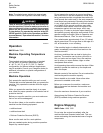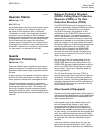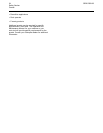
SEBU7858-03 33
Safety Section
Operator Station
i03634321
Operato r Station
SMCS Code: 7000
S/N: DBD1-Up
Any modifications to the inside of the operator station
should not pr
oject into the operator space or into
the space for the companion seat (if equipped).
The addition of a radio, fire extinguisher, and other
equipment m
ust be installed so that the defined
operator space and the space for the companion seat
(if equipped) is maintained. Any item that is brought
into the cab
should not project into the defined
operator space or the space for the companion seat
(if equipped). A lunch box or other loose items must
be secured
. Objects must not pose an impact hazard
in rough terrain or in the event of a rollover.
i01992325
Guards
(Operator Protection)
SMCS Code: 7000
There a re different types of guards that are used to
protect the operator. The machine and the machine
application determines the type o f guard that should
be used.
A daily inspection of the guards is required in order to
check for structures that are bent, cracked or loose.
Never operate a machine with a damaged structure.
The operator becomes exposed to a hazardous
situation if the machine is used improperly or if poor
operating techniques are used. This situation can
occur even though a machine is equipped with an
appropriate protective guard. Follow the established
operating procedures that are recommended for your
machine.
Rollover Protective Structure
(ROPS), Falling Ob ject Protective
Structure (FOPS) or Tip Over
Protection Structure (TOPS)
The ROPS/FOPS Structure (if equipped) on your
machine is specifically designed, tested and certified
for that machine. Excavators are not equipped
with ROPS structures. Any alteration or any
modification to the ROPS/FOPS Structure could
weaken the structure. This places the operator
into an unprotected environment. Modifications or
attachments that cause the machine to exceed the
weight that is stamped on the certification plate also
place the operator into an unprotected environment.
Excessive weight may inhibit the brake performance,
the steering performance and the ROPS. The
protection that is offered by the ROPS/FOPS
Structure will be impaired if the ROPS/FOPS
Structure has structural damage. Damage to the
structure can be caused by an overturn, a falling
object, a collision, etc.
Donotmountitems(fire extinguishers, first aid
kits, work lights, etc) by welding brackets to the
ROPS/FOPS Structure or by drilling holes in the
ROPS/FOPS Structure. Welding brackets or drilling
holes in the ROPS/FOPS Structures can weaken
the structures. Consult your Caterpillar dealer for
mounting guidelines.
The Tip Over Protection Structure (TOPS) is
another type of guard that is used on mini hydraulic
excavators. This structure protects the operator in
the event of a tipover. The same guidelines for the
inspection, the maintenance and the modification of
the ROPS/FOPS Structure are required for the Tip
Over Protection Structure.
Other Guards (If Equipped)
Protection from flying objects and/or falling objects is
required for special applications. Logging applications
and demolition applications are two examples that
require special protection.
A front guard needs to be installed when a work
tool that creates flying objects is used. Mesh
front guards that are approved by Caterpillar or
polycarbonate front guards that are approved by
Caterpillar are available for machines with a cab or
an open canopy. On machines that are equipped with
cabs, the windshield should also be closed. Safety
glasses are recommended when flying hazards exist
for machines with cabs and machines with open
canopies.
If the work material extends above the cab, top
guards and front guards should be used. Typical
examples of this type of application are listed below:


















